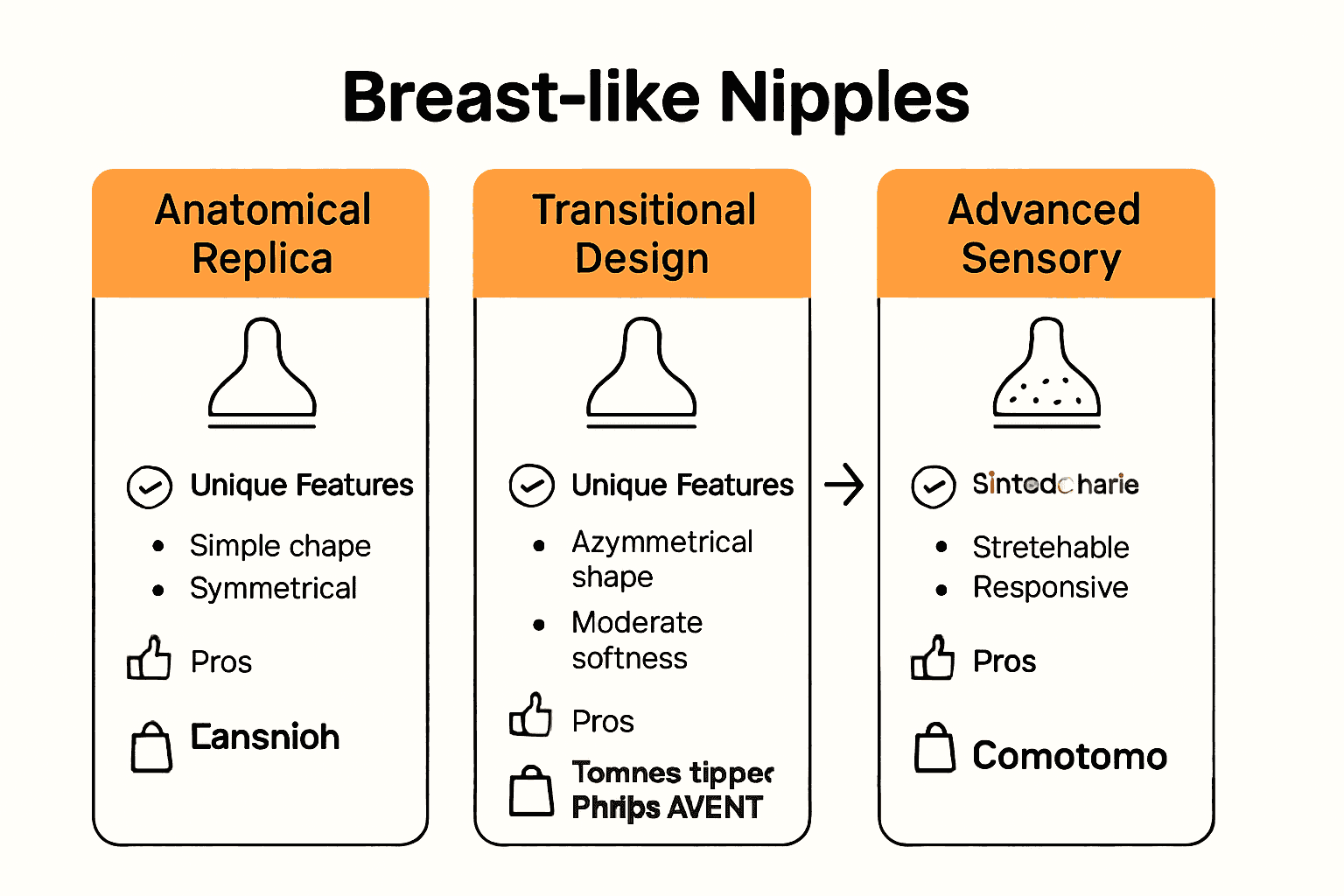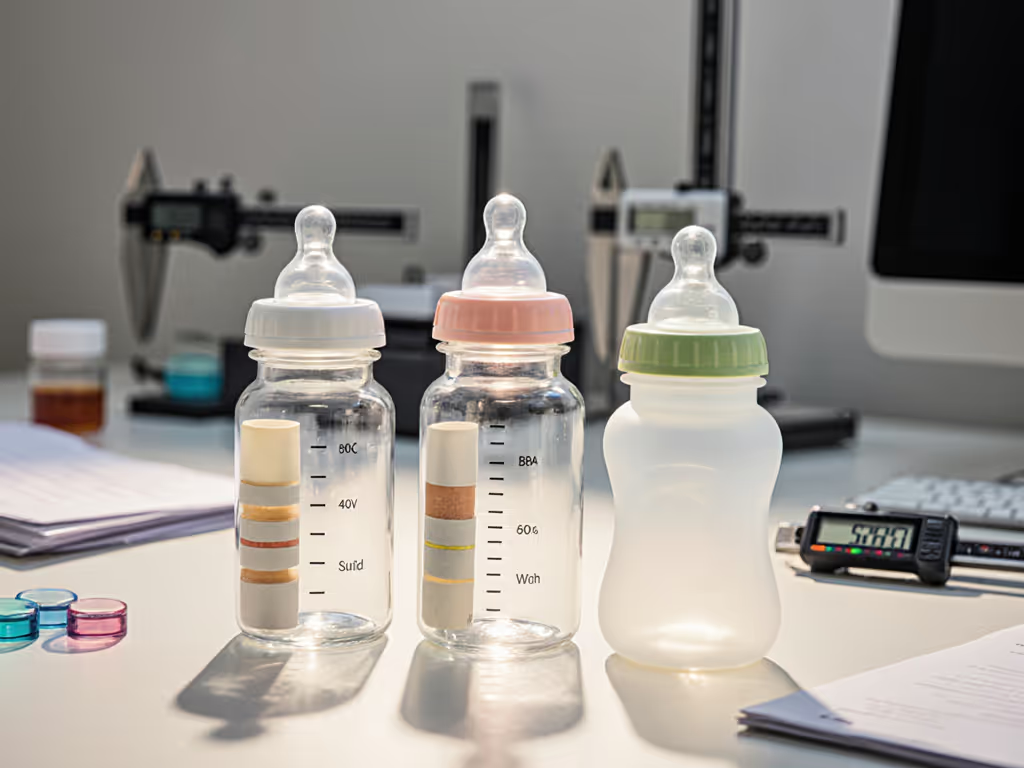
Complete Guide to Breast-Like Nipples for Babies

Did you know that up to 94 percent of babies adapt quickly to breast-like bottle nipples designed to mirror the shape and feel of a mother’s breast? Many parents struggle with babies refusing bottles or experiencing nipple confusion as they move between breastfeeding and bottle feeding. Understanding how breast-like nipples work—and what sets them apart—can make feeding easier and more comfortable for both parent and child.
Key Takeaways
| Point | Details |
|---|---|
| Breast-Like Nipple Concept | These nipples are designed to closely mimic maternal anatomy, easing the transition between breastfeeding and bottle feeding. |
| Categories of Nipples | Three main types exist: Anatomical Replica, Transitional Design, and Advanced Sensory, each catering to specific infant feeding needs. |
| Benefits for Feeding | They help reduce nipple confusion, maintain natural sucking rhythms, and provide psychological comfort during feeding. |
| Importance of Selection | Choosing the right nipple involves understanding flow rates and infant preferences to create a supportive feeding experience. |
Defining the Breast-Like Nipple Concept
Breast-like nipples represent an innovative solution in infant feeding technology designed to bridge the gap between breastfeeding and bottle feeding. These specialized bottle nipples are meticulously engineered to mimic the natural shape, texture, and physiological characteristics of a mother's nipple, creating a seamless transition for infants who alternate between breastfeeding and bottle feeding.
Anatomical Similarity is the core principle behind breast-like nipples. They are carefully crafted to replicate key features of human nipples, including:
- Soft, flexible silicone material that approximates human tissue
- Gradual, natural tapering similar to maternal nipple shape
- Variable flow rates that match infant sucking patterns
- Textured surfaces that feel more organic to babies
The primary goal of breast-like nipples is reducing nipple confusion - a common challenge where babies struggle to switch between breast and bottle. By providing a more natural feeding experience, these specialized nipples help infants maintain their preferred sucking rhythm and technique. Research from lactation specialists suggests that babies using breast-like nipples experience smoother feeding transitions, potentially reducing stress for both infant and caregiver.
From a developmental perspective, breast-like nipples are not just about feeding convenience. They represent a thoughtful approach to infant nutrition that respects the complex physiological and psychological aspects of early feeding experiences. By closely mimicking maternal anatomy, these nipples support natural oral motor development, helping babies maintain the sophisticated muscle movements learned during breastfeeding.
Main Types of Breast-Like Nipples
Breast-like nipples have evolved into several specialized design categories, each addressing unique infant feeding needs and preferences. These variations aim to provide the most natural and comfortable feeding experience possible, recognizing that no two babies have identical feeding requirements.
Here's a comparison of the main breast-like nipple categories:
| Category | Key Features | Example Brands |
|---|---|---|
| Anatomical Replica | Ultra-soft silicone<br>Wide base<br>Multiple flow rates | Tommee Tippee<br>Medela |
| Transitional Design | Asymmetrical shape<br>High acceptance rate<br>Flexible material | MAM<br>Philips Avent |
| Advanced Sensory | Ergonomic contours<br>Responsive flow<br>Sensory engagement | Comotomo<br>Nanobebe |
Anatomical Replica Nipples represent the first major category, which most closely mimic human breast anatomy. These nipples feature:
- Ultra-soft silicone mimicking breast tissue texture
- Gradual, organic tapering similar to maternal nipple shape
- Multiple flow rate options matching infant sucking strengths
- Wide base design promoting natural latch mechanics
A second category includes Transitional Design Nipples, specifically engineered for babies moving between breastfeeding and bottle feeding. Brands like MAM SkinSoft have developed innovative designs with remarkable infant acceptance rates - with some studies suggesting up to 94% of babies adapt quickly to these specialized nipples. These designs incorporate:
- Asymmetrical shapes matching natural nipple contours
- Flexible materials reducing feeding resistance
- Subtle texture variations promoting intuitive latching
- Responsive flow mechanisms synchronized with infant sucking rhythms
The third significant category comprises Advanced Sensory Nipples, which integrate cutting-edge ergonomic research. These nipples go beyond simple shape replication, incorporating sophisticated features that support infant neurological and oral motor development. Manufacturers like Comotomo and Nanobebe have pioneered designs that not only look like natural nipples but also promote more complex sensory engagement during feeding experiences.

Key Features That Mimic Breastfeeding
Breast-like nipples are sophisticated engineering marvels designed to replicate the intricate dynamics of natural breastfeeding. These advanced designs go far beyond simple shape considerations, incorporating complex biomechanical features that closely mirror the physiological experience of maternal nursing.
Material Composition plays a critical role in creating an authentic breastfeeding simulation. Manufacturers utilize ultra-soft silicone that mimics human tissue characteristics, providing:
- Temperature-responsive materials
- Gentle, skin-like texture
- Flexible molecular structures
- Hypoallergenic and safe compositions
The Mechanical Design of breast-like nipples focuses on recreating the intricate biomechanics of infant feeding. Innovative features include precise architectural elements that support natural infant sucking patterns:
- Wide, rounded base promoting natural latch
- Graduated neck enabling smooth milk flow
- Asymmetrical contours matching breast shape
- Variable compression zones responding to infant suction
Advanced Sensory Synchronization represents the pinnacle of breast-like nipple technology. These designs incorporate subtle engineering nuances that replicate the dynamic interaction between infant and mother during breastfeeding. By integrating responsive materials and intelligent design principles, manufacturers create nipples that not only look like natural breasts but also behave like them - adapting to individual infant feeding rhythms and providing a seamless, stress-free feeding experience.
Benefits and Challenges for Infant Feeding
Breast-like nipples represent a sophisticated solution to the complex challenge of infant feeding, offering a nuanced approach that balances technological innovation with natural physiological needs. While these specialized nipples promise significant advantages, they also present unique considerations that parents must carefully navigate.
Feeding Transition Benefits are the primary advantage of breast-like nipples. These innovative designs support smoother transitions between breastfeeding and bottle feeding, addressing a critical concern for many parents. Key advantages include:
- Reduced nipple confusion risk
- Preservation of infant's natural sucking rhythms
- Psychological comfort through familiar sensory experiences
- Minimized feeding stress for both infant and caregiver
However, Potential Challenges emerge alongside these benefits. Not all babies respond identically to breast-like nipple designs, and individual feeding dynamics can vary significantly. Parents might encounter:
- Inconsistent latch responses
- Varying flow rate adaptability
- Individual preference differences
- Potential initial resistance to new nipple designs
Understanding these nuanced dynamics requires a personalized approach. Successful implementation of breast-like nipples involves patient observation, willingness to experiment with different designs, and attentiveness to the infant's unique feeding signals. The goal is not perfect replication, but rather creating a comfortable, stress-free feeding experience that supports the baby's developmental needs and nutritional requirements.
Selecting the Best Breast-Like Nipple Safely
Choosing the right breast-like nipple involves a strategic approach that balances scientific understanding with individual infant needs. Parents must navigate a complex landscape of design features, material considerations, and developmental requirements to ensure optimal feeding experiences.
Safety Criteria form the foundation of nipple selection. Critical evaluation should focus on:
- Medical-grade silicone materials
- BPA and toxin-free construction
- Age-appropriate design specifications
- Smooth, seamless surface without potential choking hazards
- Rigorous manufacturing quality standards
Developmental Matching requires careful consideration of the infant's specific feeding stage and developmental characteristics. Parents should assess:
- Appropriate nipple flow rates
- Matching nipple shape to infant's oral motor skills
- Compatibility with breastfeeding patterns
- Potential for smooth transition between breast and bottle
- Individual infant preferences and sucking mechanics
Professional consultation can provide invaluable guidance in this selection process. Pediatric nutritionists and lactation specialists recommend a personalized approach that involves observing the infant's response, being willing to experiment with different nipple designs, and maintaining flexibility. The ultimate goal transcends simple product selection - it's about creating a comfortable, nutritionally supportive feeding experience that supports the infant's growth and developmental needs.
Common Mistakes When Choosing Nipples
Navigating the complex world of infant feeding requires more than intuition - it demands careful, informed decision-making. Parents often unknowingly make critical errors when selecting nipples that can significantly impact their baby's feeding experience and developmental progression.
Flow Rate Misconceptions represent one of the most common pitfalls. Many parents mistakenly believe that a faster flow rate equals better feeding efficiency. In reality, inappropriate flow rates can lead to:
- Potential choking hazards
- Overwhelming infant feeding mechanisms
- Disrupted natural sucking patterns
- Increased air intake and potential gas
- Reduced feeding control for the infant
Compatibility Oversights frequently emerge when parents fail to consider individual infant characteristics. These critical mistakes include:
- Ignoring infant's oral motor skill development
- Selecting nipples without testing infant's response
- Overlooking subtle differences in nipple shape
- Assuming one-size-fits-all approaches
- Neglecting potential allergic reactions to materials
Successful nipple selection demands a nuanced, observational approach. Professional lactation consultants recommend systematic evaluation, patience, and willingness to experiment. The ultimate goal transcends product selection - it's about creating a comfortable, developmentally supportive feeding experience that respects each infant's unique physiological and nutritional requirements.
Find the Perfect Breast-Like Nipple to Ease Your Baby's Feeding Journey
Choosing the right breast-like nipple is more than just selecting a bottle part. It is about reducing nipple confusion, supporting your baby's natural sucking patterns, and creating calm feeding moments that both you and your infant can enjoy. We understand how challenging it can be to match safety, flow rate, and shape to your baby's unique oral motor skills and preferences. You want a solution that feels natural to your little one and keeps feeding stress away.
At familybottlefit.xyz, we offer expert guidance and tailored resources to help you navigate these exact challenges. Our comprehensive advice covers everything from flow compatibility to material safety so you can confidently pick breast-like nipples that truly mimic the breastfeeding experience. Don't let feeding frustration hold you back. Visit our complete feeding solutions and discover practical tips and product recommendations designed to make feeding easier and more natural today.
Frequently Asked Questions
What are breast-like nipples?
Breast-like nipples are specialized bottle nipples designed to closely mimic the shape, texture, and feeding dynamics of a mother's nipple, facilitating a smoother transition for infants between breastfeeding and bottle feeding.
How do breast-like nipples reduce nipple confusion in infants?
These nipples replicate key features of human nipples, such as texture and flow rates, which help infants maintain their natural sucking rhythms, thereby reducing the risk of nipple confusion commonly encountered when switching between breast and bottle.
What features should I look for in a breast-like nipple?
Key features include ultra-soft silicone material, a gradual taper for natural latching, multiple flow rates to match sucking strength, and variations in texture to enhance the feeding experience and promote oral motor development.
Are all breast-like nipples suitable for every baby?
Not every baby will respond the same way to breast-like nipples. Parents should consider their baby's individual feeding dynamics, including oral motor skills and preferences, and may need to experiment with different designs to find the best fit.
Recommended
Related Articles


Why Slow Flow Nipples Matter: Complete Guide

Step-by-Step Guide to Preventing Nipple Confusion Easily

Complete Guide to the Role of Bottle Construction


